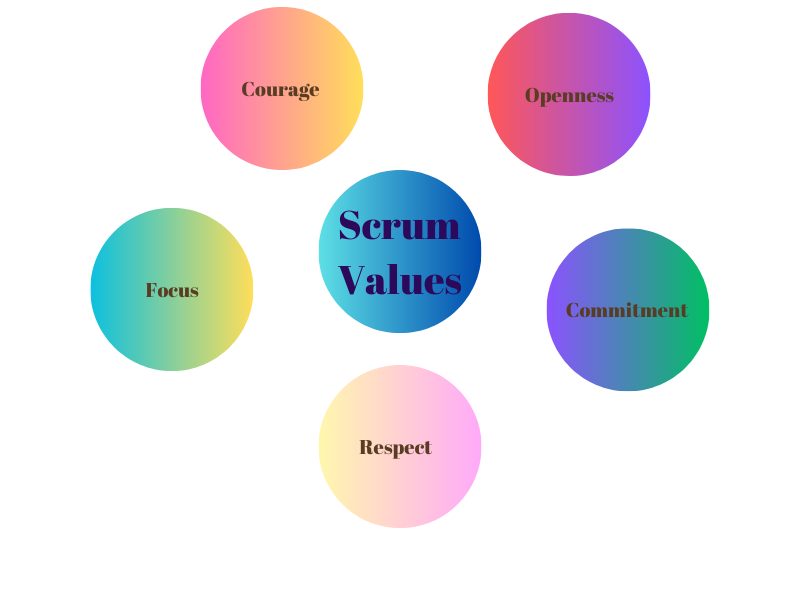
User Story
A user story is a concise, written description of a feature or functionality from an end user's perspective. It serves as a...

Scrum is an Agile framework that has been widely adopted in software development projects. Scrum is based on five values that guide the team members to work together effectively and efficiently. The values of Scrum are essential for the success of the Scrum framework, and they help create a positive and productive work environment. In this article, we will discuss Scrum values in detail, their importance, and how they are applied in Agile projects.
Scrum is built upon a fundamental set of values that promote collaboration, iteration, and Agile software development. These values include commitment, courage, focus, openness, and respect, and serve as the foundation for the Scrum methodology.
Scrum values are five key principles that guide the Scrum framework. These values are:
These values are the foundation of the Scrum framework, and they help create a culture of collaboration, transparency, and trust. They are essential for the team to work effectively and efficiently towards the project goals.
Focus is another Scrum value that emphasizes the importance of maintaining focus on the project goals and priorities. Focus is essential for achieving project goals efficiently and effectively.
To apply focus in Agile projects, team members should:
Courage is the final Scrum value that emphasizes the importance of courage in taking risks, challenging the status quo, and speaking up when necessary. Courage is essential for innovation, creativity, and continuous improvement. Team members should:
Commitment is another Scrum value that emphasizes the importance of commitment to the project goals and delivering high-quality products. Commitment is essential for building trust and fostering collaboration among team members.
To apply commitment in Agile projects, team members should:
Respect is another Scrum value that emphasizes the importance of creating a culture of respect where team members feel valued, respected, and heard. Respect is essential for building trust and fostering collaboration among team members.
To apply respect in Agile projects, team members should:
Openness is one of the Scrum values that emphasize the importance of creating an open and transparent work environment where team members feel comfortable sharing their ideas and feedback. Openness is essential for effective collaboration, continuous improvement, and adaptability.
To apply openness in Agile projects, team members should:
In conclusion, the Scrum values of openness, respect, focus, commitment, and courage are essential for successful Agile projects. By applying these values, teams can create a culture of collaboration, trust, and continuous improvement. As a result, teams can deliver high-quality products that meet the customer’s needs and exceed expectations. By embracing the Scrum values, teams can work together effectively and efficiently towards achieving project goals and objectives.
It’s important to note that the Scrum values aren’t just words on a page – they should be lived and breathed by everyone involved in the project. This includes not just the development team, but also stakeholders, the Product Owner, and the Scrum Master.
As a Scrum Master, it’s your responsibility to ensure that the team is adhering to the Scrum values and that everyone involved in the project is working together effectively. This can involve coaching team members, facilitating meetings and ceremonies, and helping to resolve conflicts and issues that arise.
Overall, the Scrum values are a key component of the Agile methodology and are essential for creating a collaborative, high-performing team. By embracing these values and working together towards a common goal, teams can deliver high-quality products that meet the needs of the customer and exceed expectations. As a Scrum Master, it’s your responsibility to ensure that the team is living and breathing these values and that everyone involved in the project is working together effectively towards achieving project success.
Implementing the Scrum values can be challenging, but there are several steps that can be taken to help ensure success:
By taking these steps, you can help to create a culture of collaboration, trust, and continuous improvement that is essential for successful Agile projects.
You may also like:
A user story is a concise, written description of a feature or functionality from an end user's perspective. It serves as a...
When implementing Scrum, it is essential to establish clear and specific goals that provide a clear direction and purpose for the project. Clear goals help the Scrum team understand what they need to achieve and why it is important. Effective communication of goals is crucial to align the entire ….
A user story is a concise, written description of a feature or functionality from an end user's perspective. It serves as a...
When implementing Scrum, it is essential to establish clear and specific goals that provide a clear direction and purpose for the project. Clear goals help the Scrum team understand what they need to achieve and why it is important. Effective communication of goals is crucial to align the entire ….
Scrum Artifacts are essential tools in the Scrum framework that provide transparency and help ensure that everyone on the team has a shared understanding of what is being worked on, what needs to be done, and what progress has been made, what has been accomplished, and what still needs to be completed. It can be used for : Prioritize work based on the product vision
0 Comments